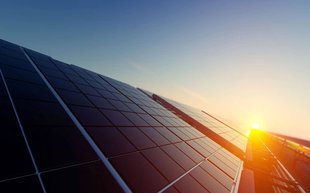Investing in Solar Energy in 2025: Pros & Cons, Best Stocks & ETFs
The global solar energy market is projected to reach $223 billion by 2026. So, there's no denying the sun is rising on a lucrative era of green investment!
How do you start investing in solar energy?
This article explores the four ways to invest in solar energy, the best solar energy stocks and ETFs to diversify your portfolio, and the pros and cons of investing in solar energy.
We’ll also check out why investing in an alternative asset like wine could be an excellent idea, including tips on how to invest in fine wines through Vinovest.
Further reading
- Here are the 15 Best Alternative Investments you shouldn’t miss in 2024!
- While at it, check out the best way to invest in wine - through these Wine Investment Apps.
4 Ways to Start Investing in Solar Energy

The best ways to invest in solar energy are:
- Stocks: Investing in solar stocks allows you to participate in the performance and growth of individual solar companies. Look for established solar companies with a solid track record, innovative technologies, and a strong market position.
- ETFs: Exchange-Traded Funds (ETFs) focused on the solar energy sector provide diversified exposure to multiple solar companies. This spreads your investment, reducing single-stock risk.
- Solar Crowdfunding: Solar crowdfunding platforms allow you to invest small amounts in specific solar projects (such as a solar farm, solar power plant, or commercial solar panel installation project) and potentially earn returns. But before investing through crowdfunding platforms, research and assess the solar energy project’s viability, financials, and management team.
- Solar Projects: Investing directly in a solar project involves allocating capital to a specific solar installation. This could be a solar power plant, a large-scale solar farm, or a commercial rooftop solar panel installation.
So, which solar energy companies should you add to your investment portfolio?
8 Best Solar Energy Stocks to Invest In
Some of the potentially profitable solar stocks to explore in 2024 are:
- First Solar (NASDAQ: FSLR)
- JinkoSolar Holding Co., Ltd (NYSE: JKS)
- SolarEdge Technologies (NASDAQ: SEDG)
- Daqo New Energy Corp (NYSE: DQ)
- Brookfield Renewable Corp (NYSE: BEPC)
- Sunnova Energy International Inc (NYSE: NOVA)
- Enphase Energy Inc (NASDAQ: ENPH)
- Orsted (OTCMKTS: DNNGY)
1. First Solar (NASDAQ: FSLR)
First Solar is a leading global provider of solar power solutions — specializing in manufacturing advanced thin-film solar modules and photovoltaic (PV) solar panel systems.
This solar company focuses on delivering sustainable and cost-effective solar energy solutions. It has vertically integrated operations, including module production, project development, and system solutions.
5-Year Stock Performance Chart

Source: Google Finance
- Market Cap: $20.5 billion
- Average Volume: 2.5 million
- P/E Ratio (TTM): 491.95
- EPS (TTM): 0.39
- Yield: N/A
2. JinkoSolar Holding Co., Ltd (NYSE: JKS)
JinkoSolar is one of the world’s largest manufacturers of solar panels. It’s renowned for producing high-quality solar panel systems and offering many photovoltaic products and services.
It offers solar energy systems for residential, commercial, and utility-scale installations.
5-Year Stock Performance Chart
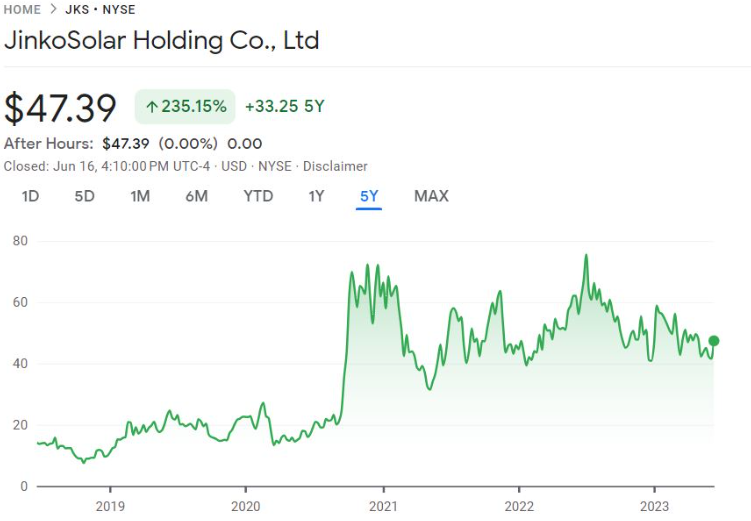
Source: Google Finance
- Market Cap: $2.39 billion
- Average Volume: 715,833
- P/E Ratio (TTM): 11.23
- EPS (TTM): 4.22
- Yield: N/A
3. SolarEdge Technologies (NASDAQ: SEDG)
SolarEdge Technologies is a leading provider of smart electricity solutions — specializing in solar inverters, power optimizers, and monitoring systems. Its products optimize energy generation, increase solar system performance, and enable smart management of energy consumption.
While it doesn’t manufacture solar panels, its products are used with solar panels to optimize energy production and monitoring.
5-Year Stock Performance Chart
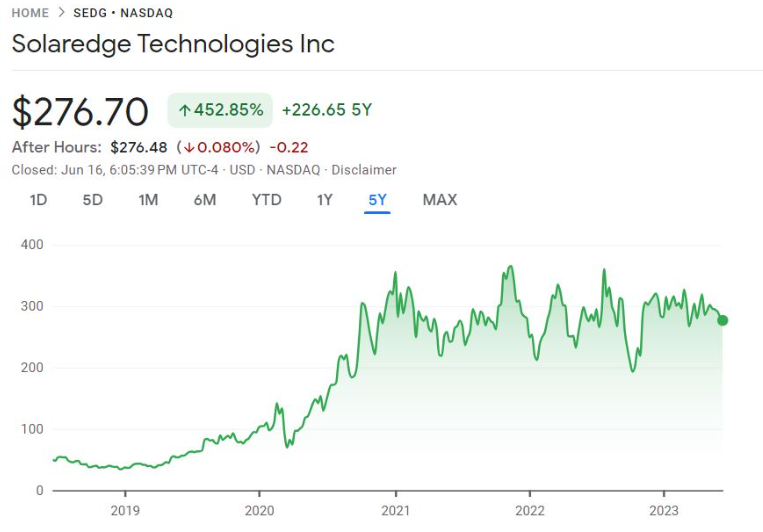
Source: Google Finance
- Market Cap: $15.59 billion
- Average Volume: 1.05 million
- P/E Ratio (TTM): 83.85
- EPS (TTM): 3.30
- Yield: N/A
4. Daqo New Energy Corp (NYSE: DQ)
Daqo New Energy Corp is a leading manufacturer of high-purity polysilicon — a key component used in solar panel cells. So while it doesn’t produce complete solar panels, it’s an important supplier of polysilicon to those who manufacture solar panels.
Its manufacturing facility in Xinjiang, China, has an annual polysilicon production capacity of 70,000 metric tons.
5-Year Stock Performance Chart

Source: Google Finance
- Market Cap: $3.30 billion
- Average Volume: 1.05 million
- P/E Ratio (TTM): 2.05
- EPS (TTM): 20.80
- Yield: N/A
5. Brookfield Renewable Corp (NYSE: BEPC)
Brookfield Renewable Corp operates one of the world’s largest publicly traded platforms for renewable energy. It owns a diverse portfolio of renewable energy assets, including solar, wind, hydroelectric, and energy storage facilities.
It’s actively involved in developing, owning, and operating wind energy farms globally — using wind turbines to generate renewable electricity.
Its renewable energy projects (such as wind power/wind energy solutions) contribute to the transition from fossil fuels to clean, sustainable energy systems — reducing the carbon footprint (carbon emission).
5-Year Stock Performance Chart
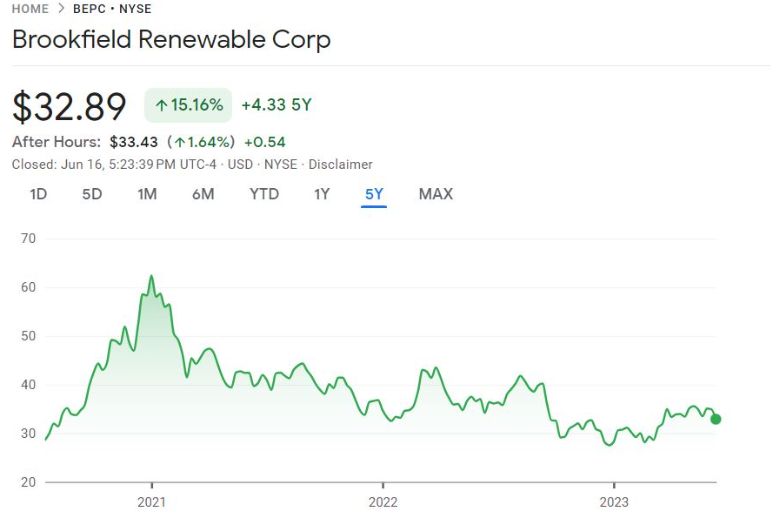
Source: Google Finance
- Market Cap: $5.67 billion
- Average Volume: 540,488
- P/E Ratio (TTM): 4.01
- EPS (TTM): 8.21
- Yield: 4.09%
6. Sunnova Energy International Inc (NYSE: NOVA)
Sunnova Energy International Inc offers homeowners solar energy systems and battery storage solutions.
This solar company operates on a lease or power purchase agreement (PPA) model. With this system, customers pay fixed monthly energy bills to use its solar system solutions to generate electricity.
5-Year Stock Performance Chart
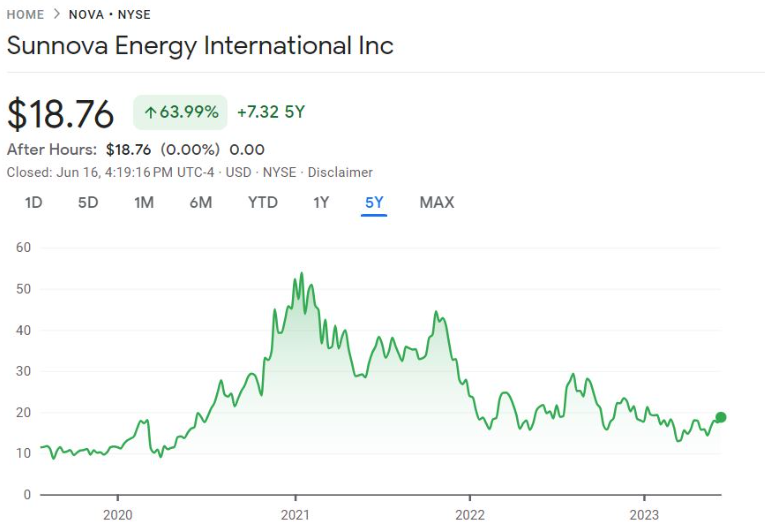
Source: Google Finance
- Market Cap: $2.18 billion
- Average Volume: 4,31 million
- P/E Ratio (TTM): N/A
- EPS (TTM): -1.86
- Yield: 0.04%
7. Enphase Energy Inc (NASDAQ: ENPH)
Enphase Energy Inc is a global leader in energy management technology, specializing in solar microinverters and monitoring systems. Its commercial solar energy system services are deployed in around 145 countries.
Its microinverters convert the DC electricity generated by solar panels into usable AC power for homes and businesses.
5-Year Stock Performance Chart
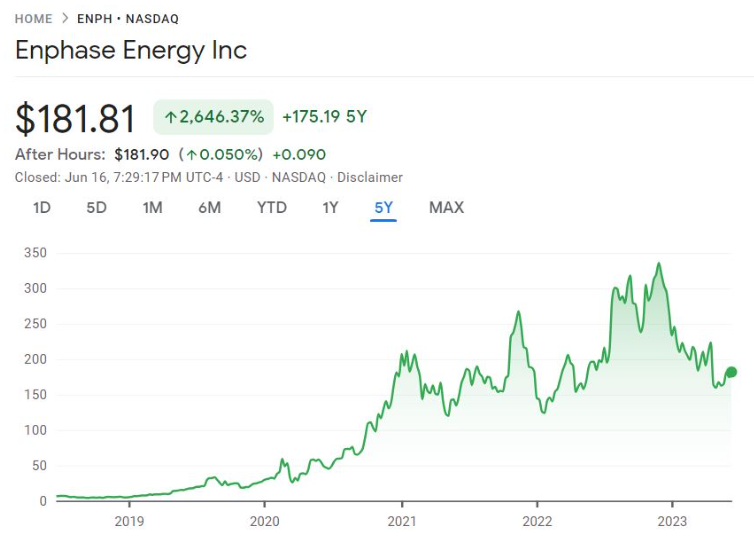
Source: Google Finance
- Market Cap: $24.92 billion
- Average Volume: 3,91 million
- P/E Ratio (TTM): 52.55
- EPS (TTM): 3.46
- Yield: 0.52%
8. Orsted (OTCMKTS: DNNGY)
This Denmark-based renewable energy company is one of the world’s largest developers of offshore wind farms. It’s recognized on the CDP Climate Change A List as a global leader in climate action.
Some of its renewable energy projects include:
- Hornsea Wind Farm: A project that produces electricity using wind turbines. The project’s total installed capacity is 6 GW.
- Sage Draw Wind Farm: Another wind energy project. This one has an installed capacity of 338 MW.
5-Year Stock Performance Chart
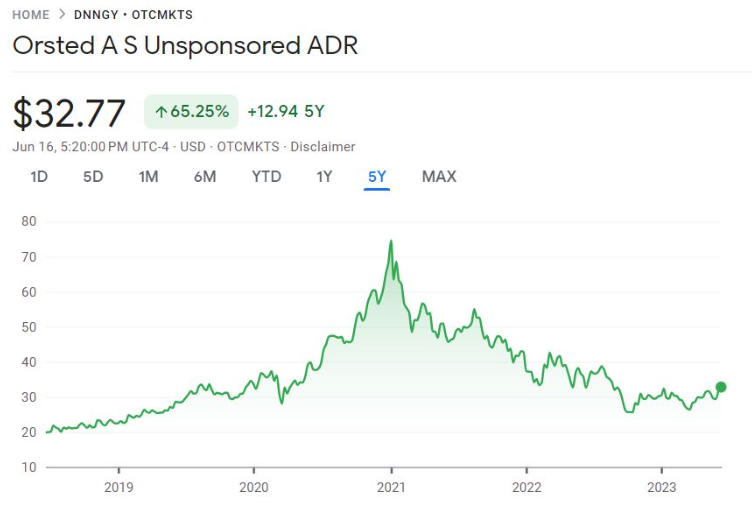
Source: Google Finance
- Market Cap: $41.31 billion
- Average Volume: 49,449
- P/E Ratio (TTM): 25.21
- EPS (TTM): 1.30
- Yield: 2.02%
Let’s now look at the ETFs you should explore.
5 Solar Energy ETFs to Diversify Your Portfolio
Here are the best AI ETFs you should explore in 2024:
- Invesco Solar ETF (NYSE: TAN)
- Fidelity Clean Energy ETF (BATS: FRNW)
- iShares Global Clean Energy ETF (NASDAQ: ICLN)
- SPDR SPDR S&P Kensho Clean Power ETF (NYSE: CNRG)
- ALPS Clean Energy ETF (NYSE: ACES)
1. Invesco Solar ETF (NYSE: TAN)
This ETF offers exposure to various global companies involved in the solar industry, including those who deal with solar installation or solar panel manufacturing. The fund tracks the MAC Global Solar Energy Index.
5-Year ETF Performance Chart

Source: Google Finance
- YTD Daily Total Return: 0.36%
- Net Assets: $2.03 billion
- Net Expense Ratio: 0.69%
- Average Volume: 634,080
- P/E Ratio (TTM): 16.60
- Yield: 0%
2. Fidelity Clean Energy ETF (BATS: FRNW)
This ETF invests in US companies engaged in clean energy-related businesses, such as renewable energy generation and energy storage. It aims to provide investment results corresponding to the performance of the Fidelity US Clean Energy Index.
5-Year ETF Performance Chart
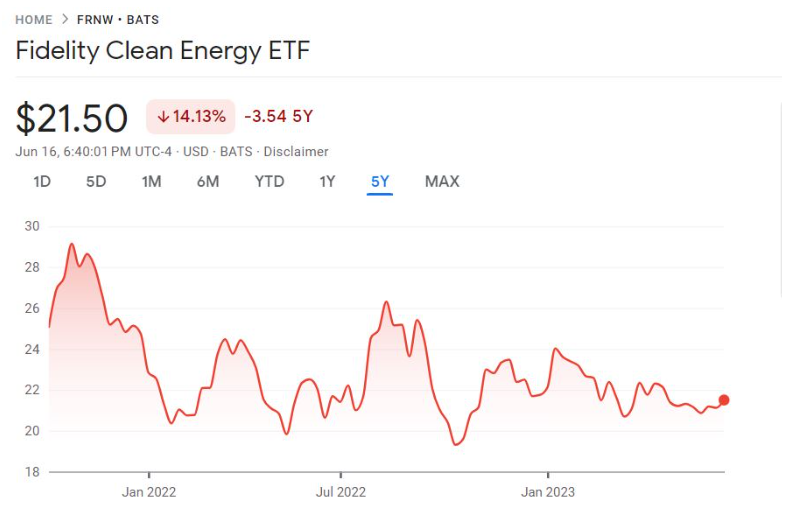
Source: Google Finance
- YTD Daily Total Return: -0.16%
- Net Assets: $38.14 million
- Net Expense Ratio: 0.39%
- Average Volume: 5,507
- P/E Ratio (TTM): 15.89
- Yield: 0.78%
3. iShares Global Clean Energy ETF (NASDAQ: ICLN)
This ETF invests in clean energy companies from across the globe, including those that use a renewable energy source like solar or wind power. The fund aims to track the S&P Global Clean Energy Index.
5-Year ETF Performance Chart
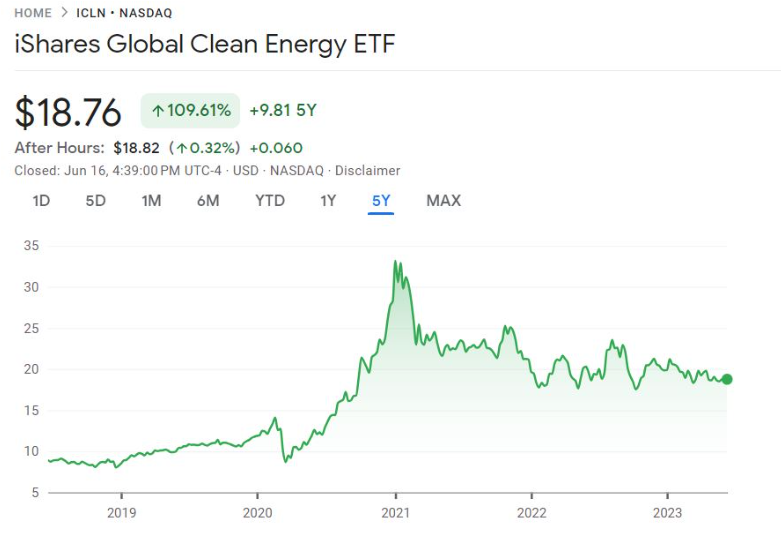
Source: Google Finance
- YTD Daily Total Return: -4.30%
- Net Assets: $4.34 billion
- Net Expense Ratio: 0.40%
- Average Volume: 2,78 million
- P/E Ratio (TTM): 20.20
- Yield: 0.96%
4. SPDR S&P Kensho Clean Power ETF (NYSE: CNRG)
This ETF invests in US companies involved in the clean power sector. The fund seeks to provide investment results corresponding to the performance of the S&P Kensho Clean Power Index.
5-Year ETF Performance Chart
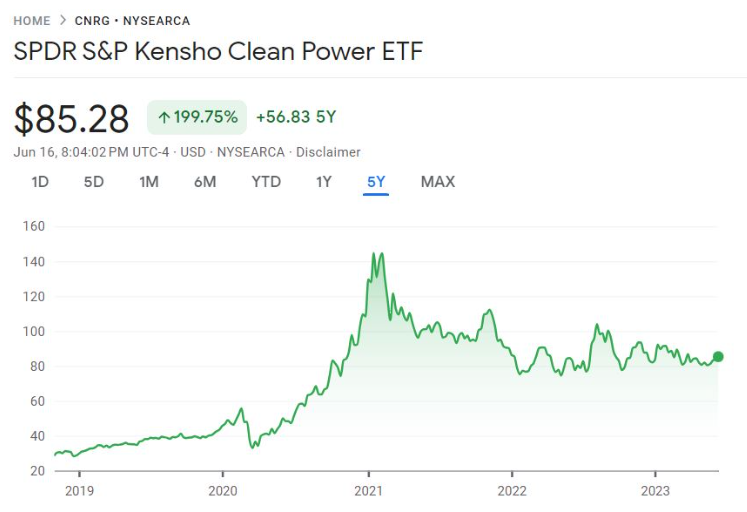
Source: Google Finance
- YTD Daily Total Return: 5.13%
- Net Assets: $321.85 million
- Net Expense Ratio: 0.45%
- Average Volume: 13,150
- P/E Ratio (TTM): 16.51
- Yield: 1.22%
5. ALPS Clean Energy ETF (NYSE: ACES)
This ETF invests in various clean energy companies from the US and Canada. It aims to track the performance of the CIBC Atlas Clean Energy Index.
5-Year ETF Performance Chart
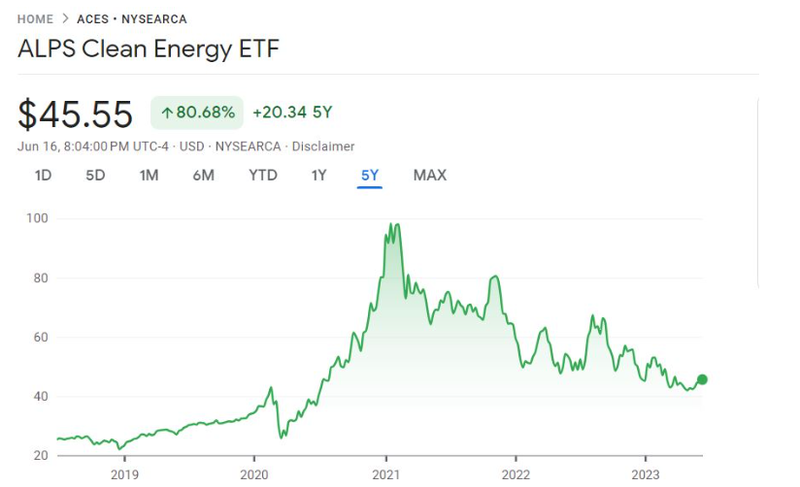
Source: Google Finance
- YTD Daily Total Return: 1.70%
- Net Assets: $465.77 million
- Net Expense Ratio: 0.55%
- Average Volume: 81,188
- P/E Ratio (TTM): 17.20
- Yield: 1.13%
What are the pros and cons of investing in the solar industry?
4 Advantages of Investing in Solar Energy
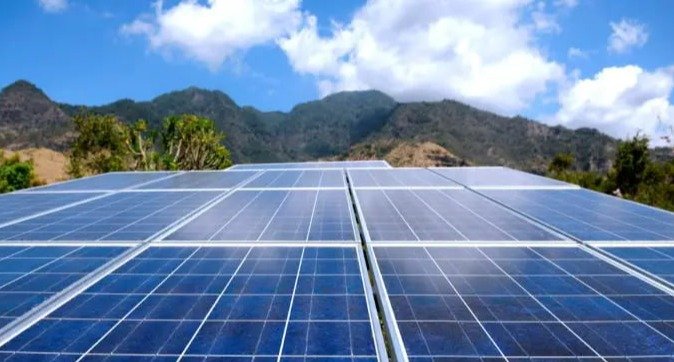
Some of the reasons to consider investing in a renewable energy source like solar power:
- Portfolio Diversification: Including solar energy in your portfolio is an excellent way to diversify and reduce investment risk.
- Environmental, Social, and Governance (ESG) Investing: Solar power generation produces clean, renewable energy and significantly reduces carbon footprint (carbon emission) and greenhouse gas emissions. So, investing in solar energy aligns with sustainability goals and combats climate change, especially for ESG-focused investors.
- Energy Independence: Solar power enables energy independence, reducing dependence on fossil fuels. This could translate to low energy bills and higher returns for investors.
- Government Incentives: Many governments offer incentives for renewable energy development, including subsidies, tax incentives like tax credits, and feed-in tariffs, which guarantee a fixed price for energy produced from renewable sources. The tax incentives may include the federal investment tax credit (ITC) that offers a percentage reduction in the tax liability based on the solar project’s cost. These policies can reduce the risk and improve the return on investment for solar projects.
Now, let’s look at the downsides of solar investment.
4 Disadvantages of Investing in Solar Energy

Here are the reasons why investing in the solar industry could be risky:
- High Valuations: The popularity of solar energy investments has led to high valuations — making it challenging to find undervalued opportunities. So before investing, you should carefully assess the valuation metrics and potential risks associated with paying a premium for solar stocks or assets.
- Complex Regulatory and Policy Considerations: The solar energy sector is subject to complex and ever-changing regulations and policies. So, varying incentives, subsidies, and tariffs across different regions can impact the profitability of your solar investment.
- Intermittent Energy Generation: Solar energy generation depends on sunlight availability and weather conditions — leading to intermittent output. This intermittency introduces operational challenges and the need for energy storage solutions. Such obstacles can increase operational costs and affect investment returns.
- Potential for Technology Obsolescence: Rapid technological advancements in the solar energy sector can lead to the potential obsolescence of existing technologies. And as more efficient solar technologies emerge, investments in older or less advanced technologies may not offer the best returns.
Want to explore another stable, profitable alternative?
Check out good old, fine wine!
Fine Wine Investment: A Profitable Alternative

Here are the various reasons why you should invest in wine:
- Potential for Long-Term Value Appreciation: Fine wines have a history of increasing in value over time and offering high returns. The rarity, limited supply, and rising global demand for prestigious wines usually drive prices upward. For example, you can expect steady returns of 6%-15% in the long run. Interestingly, Liv-ex (a global marketplace for fine wine trading) indicates that fine wine yielded 13.6% annualized returns over the past 15 years.
- Low Correlation to Traditional Investments: Wine investments have shown a low correlation to traditional financial markets. Investing in wine reduces your overall portfolio risk and enhances stability during market fluctuations. For example, the Dow Jones and S&P 500 fell -22.7% and -19.6% during the Covid-19 recession. Meanwhile, fine wine only dropped by -1.4% during the same period.
- Tangible and Enjoyable Asset: Unlike investing in the solar energy sector, investing in wine allows you to own a tangible asset. So, even if your wine doesn’t appreciate in value in the long term, you can just uncork the bottle and enjoy it.
So, it’s clear that investing in fine wine comes with lots of incentives.
Let’s now check out a hassle-free way to invest in fine wine.
How to Invest in Wine Through Vinovest

Vinovest is an AI-powered investing platform that helps you buy, store, and sell fine wines from all over the world.
Some of the benefits of investing through the platform are:
- Vinovest charges a 2.5% annual fee (2.15% for an investment portfolio over $50,000). This covers wine buying, authentication, storage, a full insurance policy at market value, portfolio management, and wine selling.
- There are some tax benefits as well. Vinovest stores your wines in climate-controlled bonded warehouses, and you don’t have to pay excise duty or VAT for this.
- Want your wine bottle delivered to your door? Vinovest can do that for you! The best part is that you get 100% ownership of your wines.
But that’s not all. Check out the Vinovest website to discover more!
Ready to Diversify Your Portfolio?
Investing in solar energy could be a great idea.
But if you’re serious about building a profitable, diversified portfolio, you should also add a stable asset like fine wine.
Visit the Vinovest website today and discover how you can buy, store, and sell investment-grade wines from across the globe.
